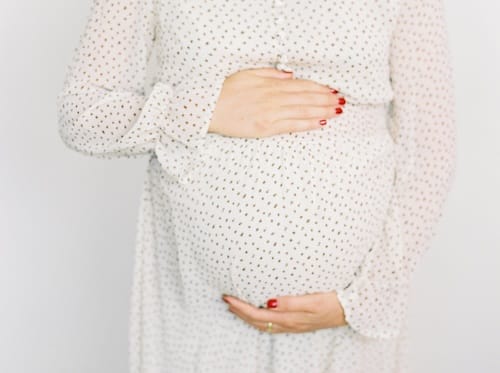Spokesperson: Erica Manto Paulson, CLD, CCE, CCHt, CMA, BFA, Founding Owner & CEO of Nurture
According to the NIH, doula intervention has been correlated to better outcomes during labor for both baby and mother, such as reduced low birth weight, cesarean section frequency, and premature labor. However, most hospitals do not formally leverage doulas, and only 6% of U.S. women engaged a doula between 2011 and 2012. Erica Paulson, Perinatal Specialist, Labor Doula, and Founder of Nurture, sees this disconnect firsthand. While hospitals and OB-GYNs deliver essential clinical care, Paulson observes that many families lack the continuous informational, emotional, and physical support they need to feel confident and cared for throughout the process, which she calls Birth With Ease.
What gap did you see in the healthcare system that inspired its creation, and how do you approach work alongside traditional medical settings like hospitals and OB-GYN practices?
I noticed a gap in how the healthcare system supports families beyond the medical aspects of pregnancy and birth. While hospitals and OB-GYNs provide essential clinical care, many families need more informational, emotional, educational, and continuous physical support. Our approach is to work alongside traditional providers, bridging the gap between medical expertise and holistic care so families feel informed, confident, and truly supported throughout their journey.
What patterns or unmet needs did you observe in hospital birth settings that influenced how you built your model of care?
In many hospital birth settings, I often saw families feeling rushed, unheard, or unsure of their options. The focus on efficiency and protocols sometimes left little room for individualized, emotional, or physiologic support. I’ve also seen how continuous, person-centered care can make a measurable difference, improving outcomes and reducing both maternal and infant mortality (Cochrane Review, 2017). Our model was built to fill that gap, creating space for education, continuity, and calm so that families feel empowered, respected, and supported alongside their medical care.
What hospitals have you worked with? Can you give us insight into your collaboration?
I’ve had the privilege of collaborating with several hospitals and statewide initiatives to make birth care more doula-inclusive and family-centered. In Cincinnati, I worked with TriHealth as part of their Advisory Committee for implementing doula-friendly practices, helping to bridge communication and practice between hospital staff, doulas, and patients.
At the state level, I served on the Ohio Doula Advisory Group for the Ohio Board of Nursing, contributing to the development of state legislation and certification standards for doulas. I’m currently partnering with two additional local hospitals on similar initiatives to integrate doula care more seamlessly into the clinical setting. My goal, both locally and nationally, is to continue fostering collaboration between hospitals and doulas so that families experience care that is coordinated, compassionate, and rooted in respect for physiological birth.
How do you see doulas complementing the work of OB-GYNs and nurses, and what does true collaboration look like in practice?
Doulas complement the work of OB-GYNs and nurses by providing the continuous emotional, physical, and educational support that clinical staff often don’t have the time or scope to offer. While the medical team focuses on safety and clinical care, doulas focus on comfort, communication, and connection during pregnancy, birth, and into their postpartum time, helping families feel heard, informed, and engaged in their experience.
True collaboration means mutual respect and clear communication, where each professional understands their role and trusts the value the other brings. When doulas and medical teams work together, families receive care that’s both clinically sound and humanizes healthcare.
How does your approach enhance both physical and emotional outcomes for mothers and babies?
Our approach integrates evidence-based education, emotional support, and mindful preparation to nurture the whole experience of birth, not just the medical event. By de-mystifying the process, we reduce fear and tension, promote relaxation, and support informed decision-making, which helps to optimize the natural physiology for safer, smoother births.
Emotionally, families feel more confident, connected, seen, heard, and cared for. That sense of calm and trust not only enhances bonding and satisfaction but also supports better physical outcomes for both mother and baby that continue well into their postpartum time.
With maternal health outcomes remaining a national concern, particularly in the U.S., how do you believe combining holistic support with medical partnerships can help close gaps in care and reduce disparities?
Maternal health outcomes in the U.S. reflect deep systemic gaps, especially around access, equity, and emotional support. By combining holistic, continuous care with strong medical partnerships, we can bridge those gaps. Holistic support helps ensure that every person is involved, seen, heard, and respected. When doulas, nurses, and physicians work together, we not only improve communication and trust but also reduce unnecessary interventions, lower stress, and ultimately support better outcomes for all families, particularly those most affected by disparities.
What does effective advocacy look like for expectant mothers navigating hospital births, and how can healthcare providers better support that partnership?
Effective advocacy in hospital birth is rooted in informed choice, respectful communication, and shared decision-making. It means ensuring that pregnant patients understand their options, feel empowered to ask questions, and know their voices carry weight in the process.
Healthcare providers can strengthen this partnership by inviting collaboration, taking time to listen, explain, and honor preferences whenever safely possible. When advocacy is seen as teamwork rather than tension, everyone benefits: parents feel respected, providers feel trusted, and outcomes improve for both mothers and babies.
Looking ahead, how do you see the relationship between traditional medicine, doula care, and holistic perinatal support evolving?
Looking ahead, I hope to see traditional medicine, doula care, and holistic perinatal support becoming far more integrated and collaborative. I want to move toward a model where emotional, physical, and informational support are seen as essential parts of evidence-based care, not alternatives to it.
My goal is to continue building partnerships with hospitals and care systems to create doula-inclusive models of care, both locally and nationally. I’ve also developed a doula training program specifically for nurses, helping them practice through a doula-informed lens. This approach strengthens communication, compassion, and continuity of care, improving outcomes for all patients, including those who may not have, or choose not to have, a doula present.
.
Meet Abby, a passionate health product reviewer with years of experience in the field. Abby's love for health and wellness started at a young age, and she has made it her life mission to find the best products to help people achieve optimal health. She has a Bachelor's degree in Nutrition and Dietetics and has worked in various health institutions as a Nutritionist.
Her expertise in the field has made her a trusted voice in the health community. She regularly writes product reviews and provides nutrition tips, and advice that helps her followers make informed decisions about their health. In her free time, Abby enjoys exploring new hiking trails and trying new recipes in her kitchen to support her healthy lifestyle.
Please note: This article is for informational purposes only and does not constitute medical, legal, or financial advice. Always consult a qualified professional before making any decisions based on this content. See our full disclaimer for more information.










